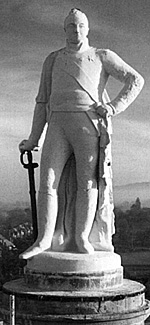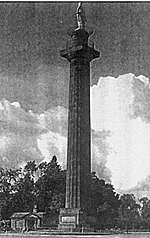A Monument to
Lord Hill
by Paul Ridgley, UK
| |
In December 1813 the Shrewsbury Chronicle ran an article suggesting that the people of Shrewsbury should in some way, honour the achievements of Lord Hill. It was suggested that a suitable column be erected in The Quarry - Shrewsbury's town gardens which have pleasant walks and are situated next to the River Severn.
The next day, over £ 400 was subscribed and other donations were soon received. At a meeting of the town it was decided that a new Market Place, with a Triumphal Arch, be built but this suggestion was declined and finally it was agreed that a Greek Doric Column should be erected at the east end of the Abby Foregate, in Shrewsbury.
A design by a Mr Haycock was agreed upon , the column to be equal in diameter to The Monument in London and one foot higher than the Paris column erected by Napoleon. It is believed that the column is the largest Doric column ever erected.
The first stone was laid on 27th December 1814. Within the foundation stone a bottle was deposited containing coins of George III, together with a copy of the Shrewsbury Chronicle, announcing the ceremony. The mayor of Shrewsbury presented the plans to the contractors who duly completed the column, and John Straphen, principal assistant to the contractors, designed and afterwards erected at his own expense the stair case within the column. This staircase consists of 172 steps, with a cast iron balustrade, and in the panel on each step is a Roman Gilt letter which together form the inscription:
" This staircase was the gift of John Straphen, the builder as his donation towards erecting this column. The first stone of the foundation was laid December 27th 1814, and completed June 1816; the anniversary of the glorious battle of Waterloo."
The last stone was actually laid of the 18th June, exactly a year to the day after Waterloo. For those interested in statistics the following may be informative:-
The pedestal is square with lions "couchant" at each corner, and on three sides are inscriptions as follows:-
ON THE NORTH SIDE
ON THE SOUTH SIDE
The foregoing is translated as follows:
ON THE EAST SIDE
The statue of Lord Hill was modelled by Panzetta, and designed and produced by Coade and Sealy of London, in an artificial stone called 'Coadestone'.
The final cost of the column, excluding the staircase and stone plinth, was just under £ 6,000.
Alongside the column a cottage was built, this was sadly demolished in 1962 to make way for a new Shire Hall. The cottage was of Doric design and had three rooms. A veteran soldier was to take the tenancy and was responsible for showing visitors the column.
Lord Hill was asked to suggest a candidate for this post and he wrote from 'Cambrey' in September 1817 proposing Sergeant Thomas Davies of the Royal Welch Fusiliers. Davies had fought at Martinique, Copenhagen, Albuera, Cuidad Rodrigo, Badajoz, Salamanca, Vittoria, the Pyranees, Orthes and Toulouse, and in 1815 became Lord Hill's orderly Sergeant.
Sergeant Davies lived in the cottage until his death in August 1820, his widow was allowed to continue the tenancy until (apparently) her death in 1835, when George Obeley, a Waterloo veteran from the Royal Regiment of Horse Guards (Blues) was appointed by Lord Hill.
The statue when removed was taken to a specialist contractor in London where a stainless steel internal frame was built, cracks were repaired and one concrete leg (a previous restoration!) and the arms were built into the body using stainless steel ties.
Lord Hill was replaced on the column in the Autumn of 1995 and apart from the use of stainless steel, all materials used were those only available at the time of the original construction.
And so Lord Hill still stands proudly gazing down on his home county. A suitable monument to a worthy man. If you are in the area do pay the column a visit , keys are available during office hours (Monday - Friday, 9 -5) from the adjacent Shire Hall. The view from the top is magnificent and don't forget to read the inscription on the staircase as you climb the steps inside.
Less than 200 yards from the column is the Lord Hill Hotel, one of the most comfortable in Shrewsbury. In the main foyer area are two splendid pictures of Lord Hill. One is a large full figure coloured print of Hill as Lieutenant Colonel Commandant of the North Shropshire Yeomanry Cavalry. He wears full dress uniform and the regimental colours can be seen in the background. The second is probably the earliest photograph of a Salopian using the Daguerreotype process. It shows the head and shoulders of Lord Hill and was taken in 1841, the year before his death, again these are well worth viewing.
More Lord Hill
|
 Rowland Hill was born at Hawkstone Park, Shropshire on August 11th 1772. His first commission was as Ensign in the 38th Regiment, and from there his career is well documented in many books and I need say no more on that part of his life.
Rowland Hill was born at Hawkstone Park, Shropshire on August 11th 1772. His first commission was as Ensign in the 38th Regiment, and from there his career is well documented in many books and I need say no more on that part of his life.
 The column and statue have been restored on at least three occasions. In 1945 one of Lord Hill's arms fell off, by 1993 the statue was beginning to crack over large areas. After investigation, and in consultation with English Heritage, the statue was removed from the column for repair. When cut into sections the full extent of the damage was realised. It had been built from a series of hollow sections with wrought iron ties and straps holding it all together. Over the years moisture had penetrated and corroded the metal work and caused the artificial 'Coadestone' to crack.
The column and statue have been restored on at least three occasions. In 1945 one of Lord Hill's arms fell off, by 1993 the statue was beginning to crack over large areas. After investigation, and in consultation with English Heritage, the statue was removed from the column for repair. When cut into sections the full extent of the damage was realised. It had been built from a series of hollow sections with wrought iron ties and straps holding it all together. Over the years moisture had penetrated and corroded the metal work and caused the artificial 'Coadestone' to crack.